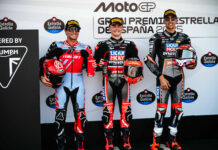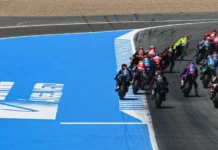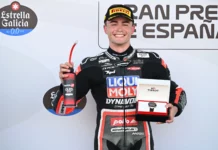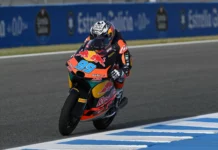Although the Motorcycle Industry Council is seemingly threatening to start its own road racing series, not everyone who is a member of the MIC is on board with the proposal and in fact, at least one of the big four Japanese motorcycle makers that belong to the MIC is preparing to compete in the Daytona Motorsports Group’s AMA and FIM-sanctioned series next year.
Roadracing World has confirmed that Yamaha was not represented in the talks that led to the June 26 announcement by the MIC that the industry group was “evaluating whether to issue a request for proposal” (sic) for a new motorcycle road racing series in the United States.
Informed sources confirmed to Roadracing World that only three manufacturers (or, three of the “over 300″ members MIC claims) were involved in a face-to-face meeting that led to the announcement: American Suzuki, represented by Mel Harris; American Honda, represented by Ray Blank and Kawasaki Motors Corp., represented by Bruce Stjernstrom.
Yamaha, according to Roadracing World’s sources, chose not to send anyone to the meeting and is preparing to race in the DMG-operated series next year. Yamaha representatives have also consulted with DMG on the rules package.
When asked on Friday which manufacturers and others were involved in the decision to announce that the MIC was evaluating whether to request proposals for a new series, MIC President Tim Buche would not identify who else was involved, but told Roadracing World, “Our process is not news. The news from an industry organization is not the process, but what the board of directors releases. Our board represents all of the interests of all of our members.”
The MIC represents more than 30 actual motorcycle manufacturers, but Buche would not identify which of them, if any, outside of Honda, Kawasaki and Suzuki had taken part in the talks which led to the announcement. Buche also did not identify which, if any, aftermarket companies also represented by the MIC took part in the discussion.
When asked whether and how input from riders, teams and sponsors would be taken into account for the new series, as well as who would sanction it, Buche said, “It’s important to look at the release, and what it says. We’re evaluating whether to request proposals.
“But it’s been our experience that our member’s interests are best served when riders and racing fans are best served. With all the changes, it simply makes sense to take a step back and look at how to have a racing series that best meets the needs of our members and their customers.”
In March, the AMA announced that it would sell its racing interests to a new group headed by CCS founder and Grand-Am President Roger Edmondson and NASCAR Vice President and International Speedway Corp. (ISC) Chairman Jim France. Inspiration for the deal came from successful series promotion deals between AMA and Live Nation (for Supercross) and from successful series promotion deals between the FIM and Dorna (for MotoGP) and the FIM and FGSport (for World Superbike).
But proposals by the new owners, known as Daytona Motorsports Group, came under fire quickly.
DMG first proposed replacing the 1000cc motorcycles that represent the currently featured Superbike class with 600cc “Daytona Superbikes,” and continuing with a “Literbike” support class with no purse and highly restrictive regulations. One justification of the emphasis on 600cc machines, although not revealed at the time, was a pending move by the FIM and Dorna to replace the 250cc Grand Prix class of the MotoGP World Championship with a 600cc-based class. That move by the FIM and Dorna has since been made public.
The proposed rules for building bikes for each class were criticized as being either unenforceable (in terms of the bike’s onboard electronics and a dyno-enforced horsepower limit) or actually encouraging tuners to build outrageously expensive engines with extensive internal modifications designed to produce more torque underneath the horsepower limits; interestingly, all four Japanese manufacturers currently support teams in the Canadian Superbike Series, which runs under the same type of dyno-limited formula, and this does not seem to be a concern north of the border.
Other critics said the series would stifle development of sportbikes and tires.
But the most contentious proposal by DMG came in the form of an announcement by Edmondson that the new series would race rain or shine at a number of tracks where the AMA does not currently race in the rain for safety reasons. Edmondson was also quoted in local newspaper reports as saying that the series would return to Loudon (now known as New Hampshire Motor Speedway) and would also go to Watkins Glen, a wall-lined road course owned by ISC.
In the face of increasingly harsh criticism and a rules package that still has not yet been finalized by DMG, the MIC’s announcement was seen as a move by some manufacturers to protect their interests in the sport, even though two of the companies (Honda and Suzuki) have not been actively engaged in discussions with DMG; DMG says the companies have ignored invitations to provide input, while Honda and Suzuki say they haven’t been given a fair chance to comment.
Meanwhile, DMG sources told Roadracing World last week that the organization had already moved away from several of its more controversial rule proposals, taking the following actions:
–Renaming the 1000cc class “American Superbike” and eliminating a dyno-enforced maximum power output of 185 horsepower in favor of something close to existing AMA Superstock engine rules, in line with ongoing calls by FIM President Vito Ippolito for National Superbike Series worldwide to move closer to production motorcycles by 2010.
–Backing away from the concept that Daytona Superbike would be the featured class and instead agreeing to promote both classes as “co-features.”
–Moving American Superbike chassis rules closer to existing AMA Superstock chassis rules but also allowing aftermarket front fork triple clamps, swingarm pivot inserts and aftermarket front brake master cylinders and discs, again in line with FIM proposals.
–Providing a purse for American Superbike, with $10,000 paid to the winner.
–Moving to ban expensive, major internal engine modifications designed to dramatically change the power delivery of 600cc four-cylinder motorcycles in Daytona Superbike.
–Agreeing to work with a rider safety committee in the future. DMG officials said they invited the existing AMA Pro Racing rider safety committee (well in advance) to participate in a track inspection with DMG staffers and Road America CEO George Bruggenthies prior to the recent AMA National at the Wisconsin track, but that the only member of the committee who actually showed up was Ben Bostrom.
–Stating that the series would not return to Loudon unless significant changes were made.
–Stating that the series would not go to Watkins Glen as it currently exists.
Stay tuned…






